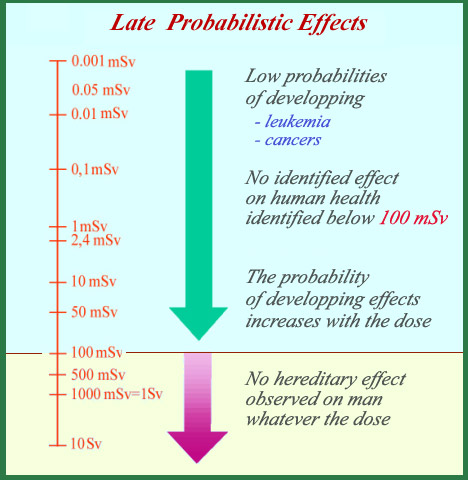The domain of low and average doses

Delayed effects and the part played by luck or unluck
It is especially delicate to make a connection between a cause and a delayed effect when such effects rarely appear and because there is no signature of the cause. If luck (or bad luck) intervenes then such effects are known as probabilistic. Clear and measurable effects have been so far only associated with doses in excess of 100 mSv, as the probability of developing a cancer increases with above this level. No matter what the dose, however, no hereditary effects of radiation have ever been observed in humans.
© IN2P3/NEPAL (Source Jean Colin)
For weak or medium-strength doses, the effects are not as clear-cut and predictable as they can be for stronger bursts of radiation. The large role played by chance in determining the potential effects of exposure has led to such effects being termed probabilistic.
These probabilistic effects correspond to cellular transformation rather than destruction, whose effcts occur generally years after the original exposure.
Symptoms such as cancers or genetic problems appear some considerable time after the radiation which may have caused them, and are therefore very difficult to distinguish from identical symptoms with different sources. Other potential causes of cancer include chemical poisoning, tobacco smoke and exposure to UV light.
In the probabilistic domain of weak doses below 100 mSv, it is the probability of a cancer appearing – and not its seriousness – that goes up with increasing dose. On an individual level, if a cancerous tumour appears a few years after exposure to radiation, it is impossible to make any valid causal connection. There is no tags allowing to link the symptoms to radioactivity.
In the general public mind, it is common to associate a cancer or a death with even a low dose of radioactivity. Such is the case for the widespread belief that a lot of people in France have developed thyroid cancers related to the Tchernobyl accident. Clear-cut cause-effect relationships are rare, and such connections can only be assumed for either very high doses or very specific symptoms. An example is the large proportion of lung cancer sufferers among uranium miners in the 1950’s before an adequate ventilation had been installed in uranium mines . In the case of the civilian and military personnel who developed cancer after working near French nuclear bomb sites in the Sahara or in Mururoa in the 1960’s, the situation is not clear. In principle doses were low in average, but exposures may have been higher for some individuals.

Did radioactivity kill John Wayne?:
An example of the uncertainty associated with probabilistic effects: John Wayne died of stomach cancer in 1979, after having filmed ‘The Conqueror’ in 1954 near the site of American nuclear bomb tests. The dose absorbed must have been small as he was able to survive for 25 years after the unfortunate encounter. With no further information to go on, one must look for other possible sources of his cancer. The fact that he smoked three packets of cigarettes a day may be a clue.
© DR
As a case study we can examine the death of the American actor John Wayne, which several newspapers attributed to exposure to radiation. Wayne died at 72 of stomach cancer, 25 years after having played Genghis Khan in a 1954 motion picture filmed in the Nevada desert. The filming site was within a hundred mile radius of Yucca Flats, one of the American nuclear bomb test sites.
Was the time he spent in this radioactive area responsible for John Wayne’s death? Let’s ignore the sensationalist melodrama proposed by a French tabloid in July 2007, suggesting that ‘the Duke’ had been exposed to a dose 400 times over the lethal limit. Had that been the case, the actor would never have survived 25 years.. His cancer may have been provoked by the unfortunate choice of filming location, but John Wayne was a heavy smoker and the radioactivity may not have been his main problem.
NEXT : Deterministic effects
Other articles on the subject « Radiation Effects »
Deterministic effects
The domain of strong doses and severe, reproducible effects For high doses above a certain thresh[...]
Dose-effects Relationship
Can effects caused by low doses of radiations be predicted ? Even though we are constantly expose[...]
Cumulative Dose
What is the cumulative exposure? We receive an average of 2.5 millisieverts (mSv) per year from n[...]
Dose Rate
Acute and chronic exposures The « effective dose » is not sufficient by itself to characterize on[...]
Hiroshima Nagasaki Survivors
An exces of cancers and leukaemia among survivors Our knowledge of the risks of cancers due to ra[...]
Linear No-threshold Model
A Precautionary Principle applied to radioactivity … Is it possible to predict the effects [...]
Low doses effects
Do low doses of radiation have any effect? Radioprotection experts commonly refer to doses below [...]
Radiosensitivity
Sensitivity of DNA in living cells to radiation Although we still know little about the effects o[...]
Radioactive Toxicity
A useful indicator but to be used appropriately … The danger presented by a radioactive sub[...]
Dose Factors
What doses when swallowing or inhaling radioactive atoms ? How to evaluate the doses resulting fr[...]